Angelfish are very popular aquarium fish. They are very popular among fishkeepers due to their distinctive shape.
Many people want to keep angelfish in their aquariums because they are so appealing. However, many people overlook the fact that angelfish require specific water conditions to survive and thrive in an aquarium.
Many people are not aware of these specific water needs. As a result, their angelfish either do not thrive or, worse, die.
Now that you understand why ideal water parameters for angelfish are important, let me explain what they are and how to keep them in your fish tank.
Table of Contents
Ideal water parameters for angelfish
| Water Parameters | Ideal Range |
|---|---|
| Temperature | 78°F-84°F (25°C-28°C) |
| pH | 6.8 – 7.8 |
| GH | 3 to 8 dGH or 54-140 ppm |
| KH | 3 to 8 dKH or 54 to 140 ppm |
| Ammonia | 0 |
| Nitrite | 0 |
| Nitrate | Less than 40 ppm (preferably 20 ppm) |
Ideal water temperature for angelfish
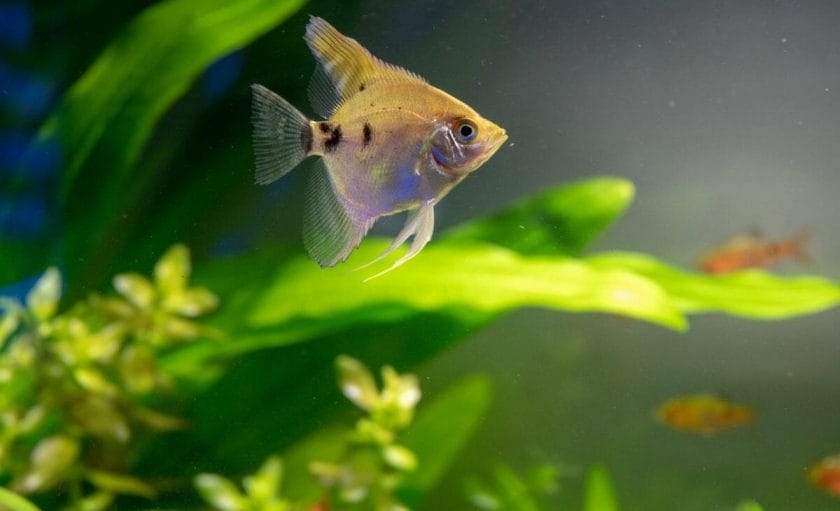
To keep your angelfish happy and healthy in your aquarium, try to mimic the temperature of the angelfish’s natural habitat.
Angelfish are native to tropical South America. The temperature is higher in these areas. Angelfish, therefore, require warmer water to survive and thrive in an aquarium.
The ideal water temperature for angelfish is between 78°-84° F (25°-28° C).
To keep your angelfish healthy, keep the temperature within this range.
How to measure the temperature of the water of your angelfish tank?
To keep the temperature of the water in your angelfish stable, first and foremost, you must know the temperature of the water and keep track of it.
Using an aquarium water thermometer is the simplest way to know and keep track of the temperature of the water in your angelfish tank.
An aquarium thermometer measures the temperature of the water in your tank continuously so you can keep track of it.
They are also very inexpensive and simple to install.
You can get a simple and inexpensive aquarium water thermometer from Amazon.
What happens if the temperature in your angelfish tank falls below 78° F (25° C)?
Fish are cold-blooded, so they cannot regulate their body temperature. That’s why changes in the aquarium water temperature affect your angelfish.
If the water temperature in your angelfish tank falls below 78° F (25° C), your fish will begin to swim more slowly than usual.
Lower water temperatures affect your angelfish’s metabolism, making them tired.
A sudden drop in temperature stresses the fish, affecting their immunity and, ultimately, causing diseases.
How to raise the temperature in your angelfish tank?
Now that you are aware of the dangers of low temperature in an angelfish tank, you may be wondering how to raise the temperature if you have found that the temperature in your fish tank is too low.
Using an aquarium water heater is the simplest and most effective way to raise the temperature in your angelfish tank.
To keep the temperature in your fish tank stable, install an aquarium heater with a built-in thermostat, such as this one (link to Amazon).
What happens if the temperature in your angelfish tank rises above 84° F (28° C)?
Angelfish have a slightly higher tolerance for high temperatures than other fish.
However, temperatures above 84 degrees Fahrenheit will make your angelfish’s metabolism fast. And you’ll notice that they’re moving faster than usual.
The real danger begins when the temperature of the water in your tank rises to 90 degrees Fahrenheit or higher.
Angelfish will become very active at that temperature and will begin to move quickly in your tank. They’ll need more oxygen to compensate for their quick movements.
The problem is that the more warm the water gets, the less dissolved oxygen it can have.
This situation can result in suffocation, and your angelfish may die as a result.
Furthermore, when the temperature reaches 90 degrees Fahrenheit, beneficial bacteria (the bacteria that convert harmful ammonia and nitrites into less harmful nitrate) begin to die.
This can result in an increase in ammonia or nitrite levels in your fish tank!
Furthermore, a sudden increase in water temperature stresses angelfish, which can lead to disease.
How to lower the temperature in your angelfish tank?
Now you know the dangers of high water temperature, you may be wondering how to lower the temperature if you noticed high temperature in your fish tank.
If you notice a rise in the water temperature, you should immediately turn off your aquarium light and heater.
After that, remove the lid from your fish tank and turn on the room’s ceiling fan. This will aid in cooling the water temperature.
Aside from these methods, there are several others for cooling aquarium water. You can learn more about them in this article.
What is the ideal pH for angelfish?
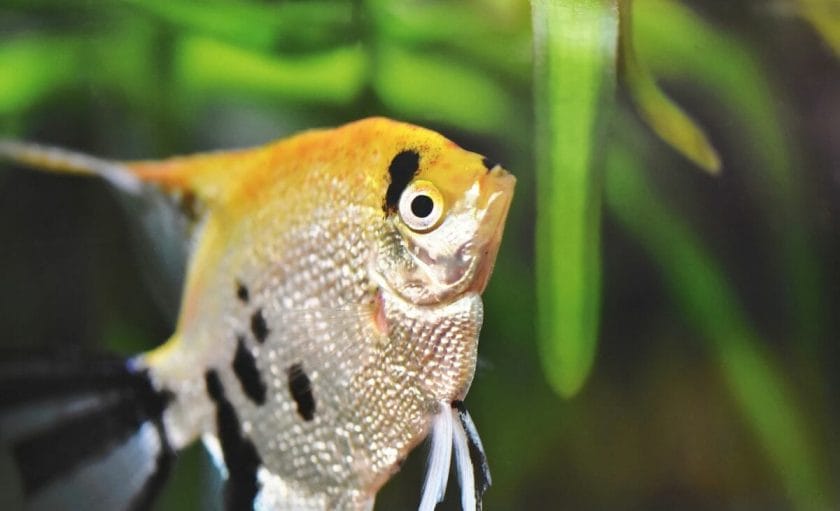
The ideal pH range for angelfish is between 6.8 and 7.8.
The pH of your aquarium will fluctuate throughout the day.
However, it is critical to keep your aquarium’s pH relatively stable. Also, avoid large pH swings. Because pH fluctuations can cause angelfish stress.
If you notice lethargic or frantic behavior in your angelfish, it may be caused by pH swings.
KH in your fish tank will help you maintain a stable pH in your aquarium because it acts as a buffer for pH swings. I’ll go into more detail about KH later in the article.
How to measure the pH of your angelfish aquarium water?
An aquarium water pH test kit, such as the API pH test kit (link to Amazon), can be used to measure the pH in your angelfish aquarium water.
How to measure pH in your angelfish tank using an API pH test kit?
The API pH test kit includes two solutions for measuring pH.
- Regular pH solution
- Super high pH solution
First, use a regular pH testing solution to check the pH of your aquarium water.
How do I use the API regular pH testing solution to measure pH?
- First of all, take 5 ml of your aquarium water in the provided test tube.
- Now add 3 drops of the regular pH solution into the test tube.
- Place the cap on the test tube and invert it several times.
- You’ll notice a change in the color of the water in the test tube.
- You should now compare the color of the water to the color chart included with the test kit.
If you notice that the color of the water is very dark blue, then your fish tank water contains high pH. So in this case, to get the accurate pH reading, test your aquarium water using the Super-high pH solution.
How to measure pH using the API super high pH solution?
Measuring the pH using the API super high pH solution is similar to measuring pH using the API regular pH solution.
- First of all, take 5 ml of your aquarium water in the provided test tube.
- Now, in the test tube, add 5 drops of the API super high pH solution.
- Place the cap on the test tube and invert it several times.
- At this point, the color of the water in the test tube should begin to change.
- Now, compare the color of the water in the test to the color chart included with the kit.
How do you lower the pH of the water in your angelfish aquarium?
If you notice that the pH of your angelfish aquarium water is higher than 7.8, you will need to lower the pH.
There are several natural methods for lowering the pH of aquarium water.
Peat moss
You can lower the pH of your aquarium by adding peat moss to your aquarium filter.
Peat moss releases tannins and gallic acids, which lower the pH and hardness of your aquarium water.
The amount of peat moss you need to add to your tank’s filter is determined by the pH of your tank and the size of your tank.
So, first, add a small amount of peat moss to the filter and check the pH level.
If you notice that the pH levels in the filter are still very high, you can add more peat moss.
Indian almond leaves
Another natural way to lower the pH of your aquarium water is to add Indian almond leaves to the tank.
Indian almond leaves are also known as catappa leaves or “the poor man’s water conditioner”.
Apart from lowering the pH of the aquarium water, Indian almond leaves have some anti-bacterial properties that can help if your fish has a bacterial infection.
To lower the pH of the aquarium water, place the Indian almond leaves directly in the tank.
Natural driftwood
Adding natural driftwood to your aquarium water is a very common and natural way to lower the pH.
You’ll need to add the driftwood directly in your tank.
Driftwood emits tannins, which reduce the pH of your aquarium’s water.
When selecting driftwood for your tank, make sure it is aquarium safe.
Another thing to keep in mind is that after you put the driftwood in your tank, the color of your tank may change to a yellowish color. It’s totally natural. In fact, many aquarists use driftwood to add color to their tanks in order to mimic angelfish’s natural habitat.
How do you raise the pH of your angelfish aquarium?
If you notice that the pH of your angelfish aquarium water is lower than the ideal range, which is 6.8, you will need to raise the pH.
There are several methods for increasing the pH of your angelfish tank.
Add crushed coral, limestone, or dolomite gravel in your fish tank.
Replacing your existing aquarium substrate with dolomite gravel. Or mixing crushed coral in your existing substrate is a very common way to raise the pH in your aquarium.
You can also put limestone or crushed coral in a mesh bag and put the bag in the filter of your aquarium to raise the pH.
Oxygenate your fish tank
Increasing the amount of oxygen in your fish tank can also raise the pH.
This is because adding too much dissolved oxygen to your fish tank reduces the amount of carbon dioxide in the tank.
Lowering carbon dioxide raises pH because carbonic acid, which lowers pH in aquarium water, is produced by carbon dioxide.
When you add more oxygen to your fish tank, you reduce the carbonic acid concentration, which raises the pH of the water in your aquarium.
Now, you may be wondering how to increase oxygen in a fish tank?
The simplest and most straightforward way to increase oxygen in a fish tank is to install an air pump.
In addition, I’ve discussed several other methods for increasing oxygen in a fish tank in this article.
What is the best KH for an angelfish aquarium?
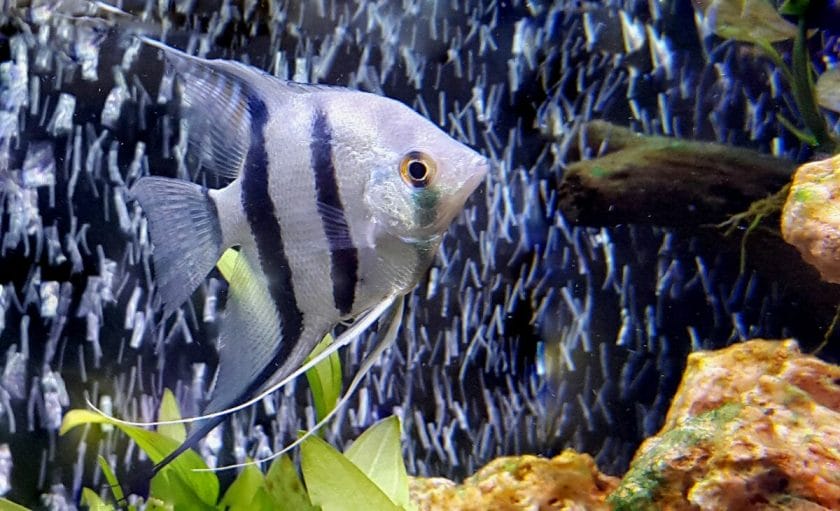
KH stands for carbonate hardness. It is a method of determining the concentration of carbonate and bicarbonate ions in water.
KH serves as a buffer for pH swings. That’s why your fish tank requires some KH.
If you don’t have any KH, the pH of your aquarium water will crash, which can be very stressful for your angelfish.
Angelfish can tolerate a wide range of KH levels. The ideal KH range for angelfish is between 3-8 dKH.
How do you measure KH in an angelfish tank?
You can measure the KH in your aquarium tank using an API KH test kit (link to Amazon).
How do I use an API KH test kit to measure KH in aquarium water?
- First of all, take 5ml of your aquarium water in a test tube.
- Now add one drop of the KH testing solution into the test tube.
- Place the cap on the test tube and invert it several times.
- Now you’ll need to keep adding one drop at a time and invert the test tube after adding each drop until the color of the water in the test tube changes from blue to yellow.
- When the color of the water changes to yellow, count the drops of the solution you added in the test tube to know the KH of your aquarium.
- For example, if the color of the water in the test tube changes from blue to yellow after adding 4 drops of the solution, your aquarium has 4 KH.
How to raise KH in your angelfish tank?
If you notice that the KH in your angelfish tank is too low (perhaps below 2 dKH), you will need to raise the KH in your aquarium.
There are several methods for increasing the KH in your aquarium.
Before I get into the methods for increasing KH in your tank, I want to make one quick point- increasing KH also raises the pH in your aquarium.
Now, this will not cause any problems because, first and foremost, angelfish can tolerate a wide range of pH, and secondly, it is preferable to have a higher pH than the pH constantly fluctuating in your fish tank because it can really stress your fish.
Partial water change
If the water in your area has a higher KH, then simply doing a partial water change of 25-30% can raise the KH of your aquarium water.
Use alkalinity buffer
To increase the KH in your aquarium, use an alkalinity buffer such as Seachem alkaline buffer.
Dolomite, aragonite, and crushed coral
To increase the KH in your aquarium, mix crushed coral, aragonite, or dolomite rock with the substrate.
How to lower the KH in your angelfish aquarium?
If you notice that the KH in your angelfish aquarium is too high (greater than 8 dKH), you should lower the KH in your tank.
There are several methods for lowering the KH in aquarium water.
Add distilled or RO-treated water.
You can lower the KH in your fish tank by adding distilled or RO treated water.
Because distilled or RO treated water contains no KH, it will dilute the KH in your aquarium water.
Put Indian almound leaves or peat moss in the tank
Adding Indian almond leaves or peat moss to your angelfish aquarium water will also lower the KH.
What is the ideal GH for an angelfish fish aquarium?
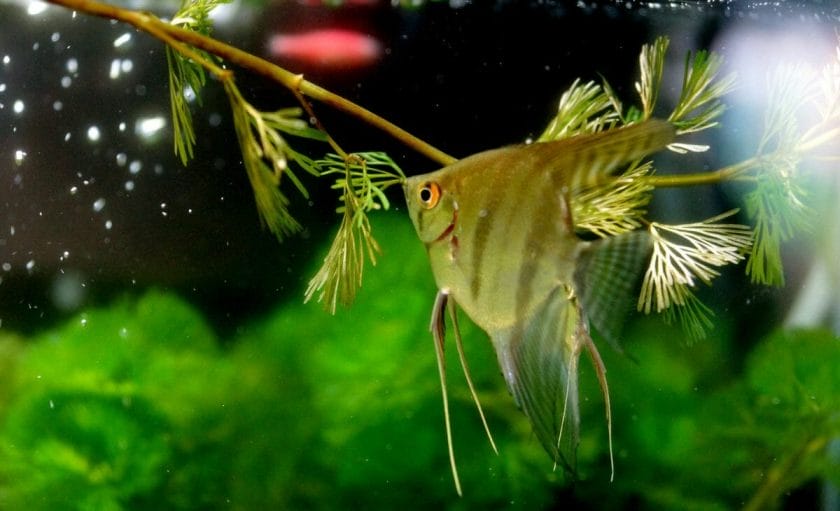
The ideal GH for an angelfish aquarium is 4 to 8 dGH. GH is a measure of calcium and magnesium ions in water.
It basically measures how hard or soft the water is.
How to measure the GH levels in your angelfish aquarium water?
Using an API GH test kit (link to Amazon), you can easily measure the GH level in your aquarium water.
How to measure GH using the API GH test kit?
- To measure GH using the API GH test kit, first fill the provided test tube with 5 ml of aquarium water.
- Now, one by one, add the GH solution drops.
- After adding each drop, replace the cap on the test tube and invert it several times.
- At the point where the color of the water in the test tube changes from orange to green, count the number of GH solution drops you’ve added to the solution in the water. That is the amount of GH in your angelfish aquarium water.
- For example, if you add 4 drops of the GH solution to the test tube and the color of the water changes from orange to green, you can say that your angel fish aquarium water has a 4 degree GH.
How to lower the GH in your aquarium?
If you notice that the GH of your aquarium water is greater than 4 dGH, you will need to reduce the hardness of your aquarium water.
There are several methods for lowering the GH of your angelfish aquarium.
Add RO filtered water into the fish tank
Because RO filtered water contains no minerals, it has no hardness.
So, if you add RO water to your aquarium and do a partial water change, you will dilute the GH in your aquarium water.
Use water softening pillow
You can lower the GH of your aquarium water by attaching a water softening pillow to your aquarium filter. These water softening pillows are similar to sponges found in canister filters or hang on the back (HOB filter).
When water flows through it in the filter, minerals such as calcium and magnesium are removed from the water, raising the GH of your aquarium water.
Attaching a water softening pillow to your filter is a quick and easy way to reduce the GH of your aquarium water.
How to raise the GH levels in your angelfish aquarium water
As previously stated, GH essentially measures calcium and magnesium ions present in your aquarium water.
The fish in your aquarium require calcium and magnesium for proper functioning.
So, if you have a very low GH level in your aquarium, it can cause health problems for your angelfish and even live plants in your aquarium.
If your aquarium has a very low GH, for example, less than 4 dGH, you should increase the GH of your aquarium water.
Do a partial water change
If the water that you use to do the partial water change of your aquarium water has high GH then you can simply do a partial water change to raise the GH of your aquarium water
Use crust coral
You can mix crushed coral with your aquarium substrate to increase the GH of your aquarium water.
Because crust coral contains a high concentration of calcium carbonate, it will raise your aquarium’s GH.
Another consideration when using crushed coral to increase GH is that it will also increase the pH of your aquarium water.
Use Aragonite
Aragonite, like crust coral, has a high calcium carbonate content, which can increase the hardness of your aquarium water.
Aragonite comes in both rock and sand forms, so you can mix it with your substrate to raise the GH level of the water in your aquarium.
What is an angelfish’s ammonia tolerance range?
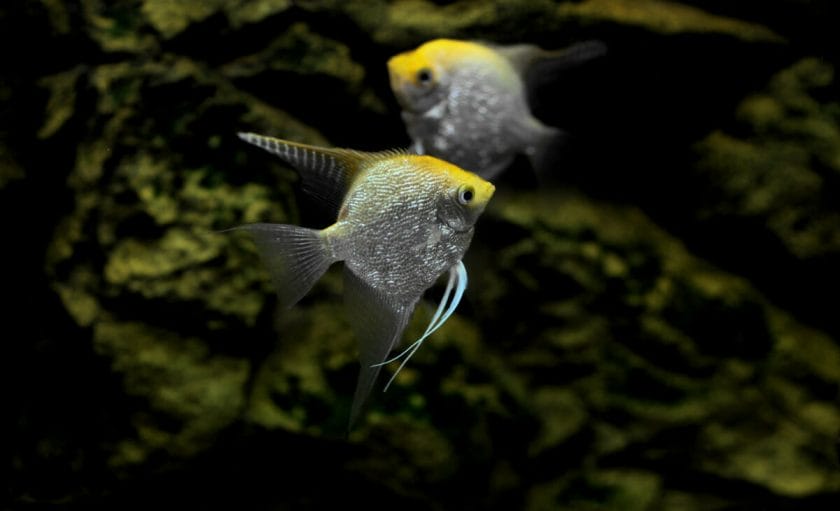
Ammonia is deadly for Angelfish. That’s why your fish tank should not have any ammonia.
How to Measure Ammonia in a Fish Tank?
Using an API ammonia test kit (link to Amazon), you can easily check the ammonia levels in your fish tank.
How to Use an API Ammonia Test Kit to Check Ammonia Levels in Your Fish Tank?
- First, put 5 ml of aquarium water in the test tube that was given to you.
- The API ammonia test kit includes two ammonia solutions for measuring ammonia levels in your fish tank.
- After taking 5 ml in the provided test tube, add 8 drops of each of the two solutions to the test tube.
- After adding the drops, put the cap on the test tube and shake the test tube rigorously for 5 minutes.
- At this point, you should notice that the color of the water in the test tube is changing.
- The API aquarium ammonia test kit includes a color chart, so you will need to hold the test tube up to the color chart to check how much ammonia is in your angelfish aquarium.
How to Get Ammonia Out of Your Fish Tank?
As previously stated, ammonia is lethal to angelfish, so if you notice any ammonia levels in your fish tank, you should remove it as soon as possible.
There are several ways to get rid of ammonia from your fish tank.
Partial water change
As soon as you noticed there was ammonia in your angelfish aquarium, you should change 20 to 30 percent of the water.
A partial water change will dilute the levels of ammonia in your angelfish tank.
Cycle your aquarium
If you notice high levels of ammonia in your fish tank, it is likely that your tank is not cycled.
Cycling a fish tank is essentially the process of housing beneficial bacteria in your aquarium that will convert harmful ammonia into less harmful nitrite, then nitrates, and finally nitrates.
Here are several methods for cycling your aquarium.
Improve your aquarium’s filtration.
If your aquarium does not have enough filtration for the size of the aquarium or the number of angelfish in it, you will need to level up the filtration in order to remove ammonia from the tank.
You can improve the filtration by replacing your aquarium filter with a larger filter. Alternatively, you can add another small filter on top of your existing filter.
If you want a larger filter for your fish tank, here is a list of the best canister filters for your aquarium.
If you want to add another filter to your existing filter, a hang on the back filter is a good idea because it is very effective at filtering water, takes up little space, and is inexpensive.
The following is a list of the best hang on the back filters on the market.
What is the nitrite tolerance range for angelfish?
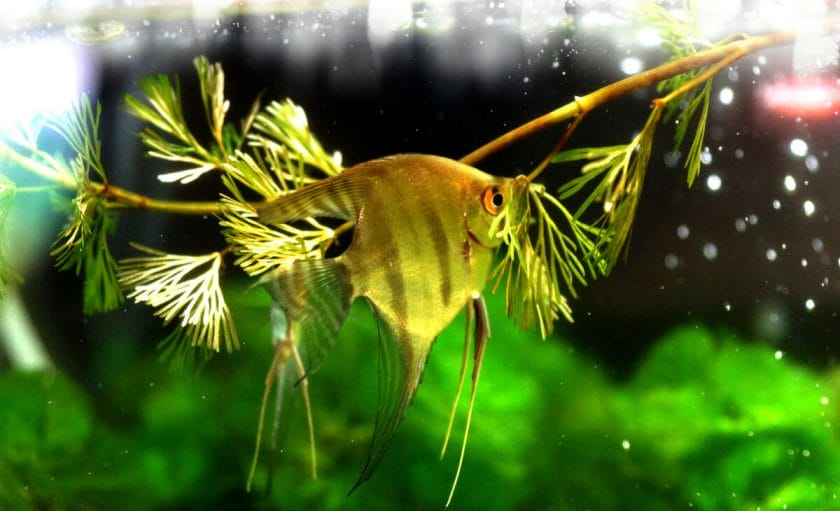
Nitrite, like ammonia, is toxic to your angelfish. Angelfish can die from too much nitrite in the water.
So there should be no nitrite levels in your fish tank.
How to Measure Nitrite Levels in an Aquarium?
Using an API nitrite test kit (link to Amazon), you can easily measure the nitrite levels in your fish tank.
How to Use an API Nitrite Test Kit to Check Nitrite Levels in Your Aquarium?
- To begin, fill the provided test tube with 5 mL of water.
- The API nitrite test kit includes two solutions.
- You will need to put five drops of the first solution into the test tube.
- Now place the cap on the test tube and invert it several times.
- Now, pour five drops of the second solution into the test tube.
- Put the cap back on the test tube, and this time shake it hard for about 5 minutes.
- Now keep the test tube idle for about 5 minutes.
- You will now notice that the color of the water in the test tube has changed.
- To measure the nitrite levels in your aquarium, hold the test tube against the color chart provided with the test kit.
How to Get Nitrates Out of Your Fish Tank?
As I previously stated, nitrite is lethal to aquarium fish, so you should get rid of it as soon as you notice nitrite levels in your aquarium.
Do a partial water change
As soon as you notice nitrite levels in your aquarium, you should do a partial water change of about 30% of your aquarium water.
This will reduce the levels of nitrite in your aquarium.
Cycle your fish tank
Cycling your aquarium is the only long-term solution for removing nitrites.
The reason you’re seeing nitrites in your fish tank is that your fish tank is not cycled.
And since there are nitrites in your fish tank, there must have been a spike in ammonia before the nitrites.
So, you will need to cycle your aquarium to get rid of both ammonia and nitrites.
The quickest way to cycle your aquarium is to add filter media, such as sponge, from an already cycled aquarium.
So, if you have a friend who has an established or cycled aquarium, you can use the filter media from his or her aquarium and place it in your aquarium to instantly cycle your fish tank.
What is the nitrate tolerance range of angelfish?

Angelfish can tolerate nitrates up to 40 PPM.
However, it is generally recommended to keep nitrate levels below 40 PPM.
For example, if you can keep nitrate levels below 20, that is preferable to 40.
How to Measure Nitrate Levels in a Fish Tank?
The API nitrate test kit (link to Amazon) makes it simple to test nitrate levels in your aquarium.
How to test nitrate levels using an API nitrate test kit?
- First, take 5 mL of aquarium water and place it in the provided test tube.
- API test kit comes with two nitrate solution testing solutions, so first of all you will need to add 10 drops of the first solution into the test tube.
- Place the cap on the test tube and invert it several times.
- Now rigorously shake the second solution bottle and then add 10 drops of it into the test tube.
- Now put the cap back on the test tube and shake it hard for 1 minute.
- Let the test tube sit for 5 minutes so that the color can develop.
- After 5 minutes, the color of the water in the test tube should have changed, and you will now need to hold the test tube against the white background of the API test kit’s color chart to measure the nitrate levels in your fish tank.
How to remove nitrates from your angelfish tank?
As nitrates are not as harmful as ammonia or nitrites to angelfish, your angelfish can tolerate nitrates up to 40 PPM.
In general, it is best to keep nitrate levels below 40 PPM, preferably around 20 PPM.
There are two methods for removing nitrates from your angelfish aquarium.
Do a partial water change
To reduce nitrate levels in your aquarium, perform a partial water change.
You should change about 20 to 30 percent of your aquarium’s water.
In general, doing a partial water change is the only way to remove nitrates from your aquarium. Many fishkeepers do a weekly partial water change to remove nitrates that accumulate throughout the week in their fish tanks.
Plant a lot of plants in your angelfish tank
The way to get rid of nitrates from your aquarium naturally is to plant a lot of plants in it.
Nitrates are bad for your fish, but they are actually food for the plants in your aquarium.
If you put live aquarium plants in your angelfish tank, the plants will soak up the nitrates, so you won’t have to dilute or get rid of the nitrates by doing a partial water change.
One thing to keep in mind is that you will need to plant a lot of plants in your aquarium to get rid of all the nitrates.
Most of the time, it is impractical, which is why most fish keepers will perform a partial water change to remove nitrates from their tanks.
Planting a lot of live aquarium plants in the fish tank to get rid of nitrates is another way if you have planted a lot of live aquarium plants and you have fewer fish in your aquarium.
FAQ
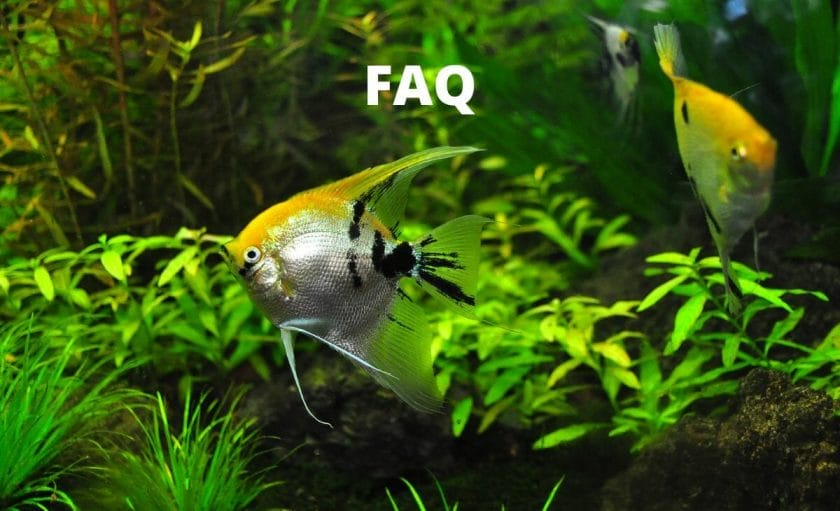
Do angelfish like low PH?
The ideal pH range for angelfish is between 6.8 to 7.8. So angelfish needs slightly acidic to a little bit basic pH.
Do angelfish like high water flow?
Angelfish do not like high water flow. Due to their unique slender body shape, they cannot swim properly in the high water current.
In their natural habitat, angelfish live in tropical areas where there is a lot of vegetation and slow moving water. So you should try to imitate the same in your aquarium.
Are angelfish sensitive to nitrates?
Generally speaking, angelfish are sensitive to high nitrates. That’s why you should keep the nitrate level below 20 PPM in your aquarium.
Is 8.4 pH too high for angelfish?
8.4 pH is too high for angelfish. The ideal pH range for angelfish is between 6.8 to 7.8. So you should try to keep the pH of the water in your angelfish tank within this range.
Can angelfish live in 7.8 pH?
The ideal pH range for angelfish is between 6.8 to 7.8. So angelfish can live in 7.8 pH water
What alkalinity do angelfish like?
Angelfish like water that is between 3 and 8 dKH in alkalinity. Alkalinity is a measure of how well water can keep pH from changing too much. Changes in pH can be stressful for angelfish, which is why you need some alkalinity in the water in their tank.
If you live in the US, the surface water in most parts of the US has some alkalinity. So if you notice that your aquarium’s water has low alkalinity, then you can simply do a partial water change to raise the alkalinity of your aquarium water.
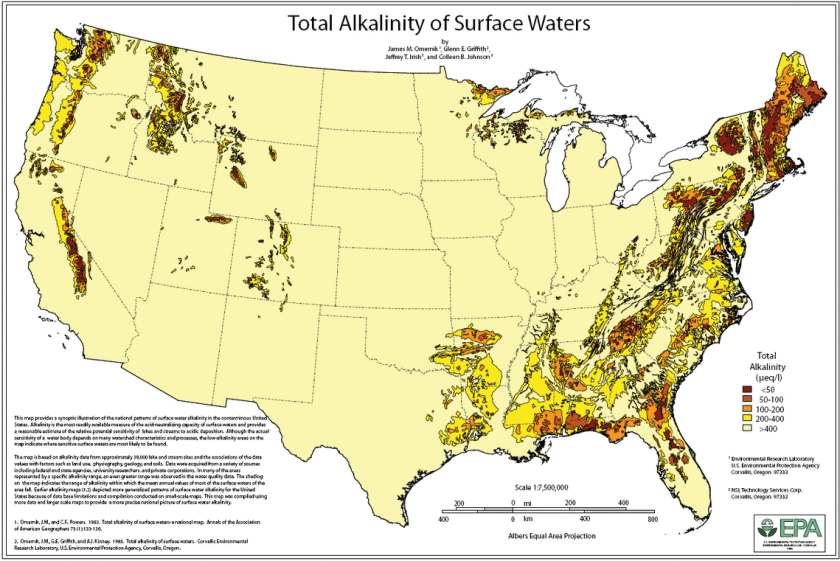
Is 20 ppm nitrate too high for a freshwater aquarium?
For most freshwater aquarium fish, 20 PPM nitrate is acceptable. However, some freshwater fish are more sensitive to nitrates than others.
For example, angelfish are more sensitive to nitrates, so in an angelfish tank, ideally, you should keep the nitrate level below 20 PPM.
What should the ammonia level be for angelfish?
The ammonia level for angelfish should be zero. Ammonia is deadly for angelfish, so your fish tank should not contain any ammonia.
How do you soften angelfish water?
There are a couple of ways to soften angelfish water.
- You can do a partial water change with RO filter water and it will soften the water in your aquarium.
- You can also use a water softening pillow, which you will need to attach to your aquarium filter. When the water moves through this pillow, it will soften your aquarium water.
Do angelfish like calm water?
Angelfish like calm water. Due to their unique slender shape, angelfish prefer slow moving, calm water compared to strong water currents. In strong water currents, angelfish are not able to swim properly.
Do angelfish need heaters?
The ideal water temperature for angelfish is between 78 to 84 degrees Fahrenheit, or 25 to 28 degrees Celsius.
So angelfish need relatively warmer water in their aquariums. So, for most angelfish tanks, you will need a heater.
What is the lowest temperature for angelfish?
78 degrees Fahrenheit or 25 degrees Celsius is the lowest temperature for angelfish. Your angelfish will really suffer and get stressed below this temperature.
Can angelfish live in 75 degree water?
The ideal temperature range for angelfish is between 78 to 84 degrees Fahrenheit. So your angelfish cannot survive at 75 degrees Fahrenheit water temperature for a long time.
Are angelfish sensitive to pH?
Captive angelfish can tolerate a fairly wide range of water pH. However, wild-caught angelfish are very sensitive to water pH.
The ideal pH range for angelfish is between 6.8 to 7.8. So you should try to keep the pH of your angelfish aquarium water within this range.
What should KH be for angelfish?
KH acts as a buffer for pH swings. pH swings stress angelfish, so you need some KH in your angelfish tank to keep the pH stable. Your angelfish tank should have a KH between 3-8 dKH.
Can angelfish live in ammonia?
Ammonia is toxic to angelfish that’s why angelfish cannot live in ammonia. As soon as you see ammonia in your fish tank, you should do a partial water change of your aquarium water to dilute ammonia levels. And cycle your fish tank to get rid of ammonia permanently.
How do fish act if ammonia is high?
When there is high ammonia in your fish tank, your fish may suffer from ammonia poisoning.
The symptoms of ammonia poisoning are as follows:
- Lethargy
- Loss of appetite
- Gasping for air
- Red or purple gills
- Bloody patches on the body
- Laying at the bottom of the tank
Conclusion
So these are the ideal water parameters for your angelfish tank.
You should always maintain the water parameters in the ideal range to give a long and healthy life to your angelfish.
I hope you found the article helpful and I’ve answered all of your questions related to the topic.
If you want to know what do angelfish like in their tank then check out this article.
Happy Fishkeeping!
